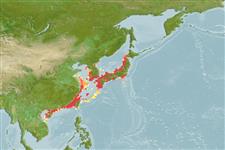Teleostei (teleosts) >
Tetraodontiformes (Puffers and filefishes) >
Tetraodontidae (Puffers) > Tetraodontinae
Etymology: Takifugu: A Japanese word with several meanings; taki = waterfall + fugu = fish; it could be also understood as taki = to be cooked in liquid + fugu = a venomous fish.
More on authors: Jordan & Snyder.
Environment: milieu / climate zone / depth range / distribution range
Ecology
Marine; demersal. Temperate
Northwest Pacific: Japan and southern Korea to Vietnam (Ref. 46893).
Size / Weight / Age
Maturity: Lm ? range ? - ? cm
Max length : 15.9 cm TL male/unsexed; (Ref. 125279); max. published weight: 83.30 g (Ref. 125279)
During high tide, mature individuals swim ashore in large numbers and spawn on beaches. Eggs are left partially buried in sand and rubble (Ref. 240).
Life cycle and mating behavior
Maturity | Reproduction | Spawning | Eggs | Fecundity | Larvae
During high tide, mature individuals swim ashore in large numbers and spawn on beaches. Females spawn on the surface with two or more males biting and hanging on to the ventral surface of each female. Eggs are left partially buried in sand and rubble (Ref. 240).
Masuda, H., K. Amaoka, C. Araga, T. Uyeno and T. Yoshino, 1984. The fishes of the Japanese Archipelago. Vol. 1. Tokai University Press, Tokyo, Japan. 437 p. (text). (Ref. 559)
IUCN Red List Status (Ref. 130435)
Threat to humans
Poisonous to eat (Ref. 9137)
Human uses
More information
ReferencesAquacultureAquaculture profileStrainsGeneticsElectrophoresesHeritabilityDiseasesProcessingNutrientsMass conversion
Tools
Can't connect to MySQL database fbquizv2. Errorcode: Too many connections
